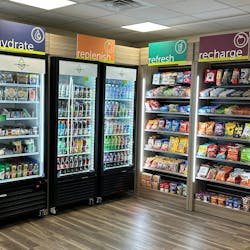What is cloud computing?
A lot of people are talking about cloud computing these days. It has become a popular catch phrase among techies and followers of all things Internet. Although commentators may use a variety of terms, including "hosted," "net resident" or "SaaS" to describe it, cloud computing essentially works like this; instead of purchasing a software application, then installing, managing and maintaining it on your own servers, you simply access the required software and resources from a dedicated provider.
A useful analogy is power generation. Most business owners do not build and maintain their own onsite power generation infrastructure. Instead, they typically tap into a wider power grid which allows them to access more power when they need it and less when they don’t. It’s easy to understand how such a model makes sense when it comes to your utility bill, but that same principal holds true for your information technology (IT) expenses as well.
Not surprisingly, the prospect of lower IT costs, and greater flexibility, has piqued the interest of many business owners, and technology providers are subsequently focusing more and more on the cloud as a viable delivery option.
During a recent presentation on the topic, Microsoft CEO Steve Ballmer noted 70 percent of Microsoft's 40,000 employees are currently working on cloud-based projects and by 2012 that number will exceed 90 percent. In fact, Ballmer has recently gone further projecting all software will eventually be located in the cloud.
Growth Of Cloud Computing
"The cloud" has seen exponential growth over the past two to three years and there is no sign of it slowing down. Technology providers are positioning themselves to leverage the shift to the cloud, while a more progressive customer base begins to think strategically about the potential for cloud-based deployments to improve their internal processes and bolster their bottom lines. Cloud-based service revenue reached $68.3 billion in 2010, a 16.6 percent increase over 2009, and according to industry research firm Gartner Inc, revenues are projected to grow to nearly $150 billion by the end of 2014. Gartner's study goes on to point out that 50 percent of the Global 1000 enterprises expect to be using cloud-based solutions for their top 10 key revenue generating processes by 2015.
Cloud Computing And Your Balance Sheet
There is a clear and growing consensus that cloud computing is set to bring significant benefits to organizations and will likely be the primary method of acquiring software in the future. It is therefore vital that business leaders familiarize themselves with the benefits and challenges associated with the cloud.
The primary reason cloud solutions are attracting so much attention is their potential impact on the corporate balance sheet. The cloud computing model eliminates the upfront investments in software, servers and licensing, which represent a significant capital expenditure and replaces it with a modest and predictable operating expenditure. In other words, the cloud allows the business owner to match operating expenses with operating revenues.
That migration from capital expenditures to operating expenditures is significant as it gives users the option to eliminate the expense if necessary. With a traditional on-premise software solution, the firm is fully committed to those hardware, software, support and licensing costs, regardless of whether the resources is being fully utilized or not. This drive to eliminate capital expenditures in favor of operating expenditures has become increasingly important recently as banks have made financing large scale capital investment progressively more difficult. And in a capital intensive industry like vending, stretching the capital expenditure budget as far as possible is vital.
Total Cost Of Ownership
When comparing on-premise software and cloud-based solutions, it is important to have a full understanding of the total cost of ownership associated with each model. Business owners are often surprised to learn that with on-premise server based solutions, the initial software purchase typically represents roughly 20 percent of the total cost of ownership (TCO) over the lifetime of the application.
The reaming 80 percent of the TCO equation is made up of a combination of both direct and indirect costs. Direct costs are fairly straightforward and include the expenses directly linked to the day-to-day running of the required hardware, including power, floor space, storage and the direct IT resources required to manage and monitor the application.
Indirect costs may include networking, security issues, training, deployment and testing of upgrades, scheduled replacement of hardware and unscheduled outages. Typically more than half of these costs are associated with the personnel tasked with maintaining, repairing or monitoring either hardware or software, which provides no directly measurable value to the organization other than maintaining the status quo.
Beyond The Balance Sheet
The move to cloud computing allows organizations to focus on their core business and, although it may be difficult to quantify, the ability of any business to focus on its core concerns is fundamental to its long-term success. In fact, many proponents argue that this value side of the equation is actually more compelling than the potential cost savings associated with the cloud model.
For example, because cloud applications are Web-based, the end user is able to access their IT services and data 24/7 from essentially anywhere in the world. And because users are typically very familiar with using the Internet as a tool, cloud applications tend to have a higher adoption rate with a much lower learning curve when compared to traditional software.
With a cloud-based application, the software provider manages all updates and upgrades so there are no patches or releases for customers to download or install. As a result, the end user can be assured they are always working with the latest software version. This is not always the case with traditional software, which places the burden on the user to download, install and test upgrades and revisions themselves.
And finally, the cloud is leveling the playing field. Small and mid-sized operators are no longer limited by their size. The benefits that sophisticated software solutions can provide are now available to any business owner willing to innovate and move to the cloud.
What Does It Mean To You?
Cloud computing represents a significant shift, not only within the IT sector, but the wider business community in general. End users need to understand what the cloud means for their business prior to undertaking a thorough due diligence review and potentially committing to a provider.
Consider your current and future business requirements; is maintaining your own servers and network critical to your core operation, or could your organization benefit by reallocating that responsibility to someone else, and what could the accessibility and flexibility a cloud-based application affords you as a business owner mean to the way you communicate with your employees, partners and clients?






